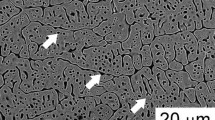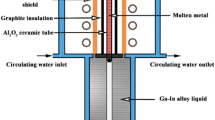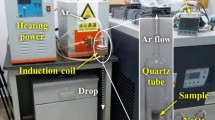Abstract
Immiscible alloys, whether in well-mixed or layered forms, are of increasing interest based on their novel structural and functional properties, such as enhanced thermal stability against grain growth or radiation-induced defect trapping at the interfaces. To address the need for new approaches to tailor microstructures, the microstructural development of an immiscible Cu-4 wt.% Nb alloy processed via friction consolidation of elemental powders is investigated. Friction consolidation is a solid phase processing technique that imparts severe plastic strain into a deforming volume resulting in elevated temperatures below the melting temperature of the alloy. Two distinct processing pathways were chosen to understand the effect of thermomechanical conditions on the final microstructure. The microstructure was characterized using scanning electron microscopy, scanning transmission electron microscopy, and X-ray diffraction techniques. Path 1 exhibited larger strain, strain rate, and temperature as compared with path 2. In path 1, agglomerated Nb particles were present in the recrystallized ultrafine-grained Cu matrix, while in path 2 extremely fine and dispersed Nb particles were present in a highly deformed Cu matrix. In both pathways, supersaturation of Cu in Nb lattices was noted, but not vice versa. The asymmetry in mixing is explained based on deformation-based, thermodynamic and kinetic factors. These findings provide a pathway for creation of novel tailored microstructures and improved properties in any number of binary immiscible alloy systems.









Similar content being viewed by others
Data availability statement
The raw/processed data required to reproduce these findings can be obtained upon a direct request to the corresponding author.
References
Tschopp MA, Murdoch HA, Kecskes LJ, Darling KA (2014) Bulk nanocrystalline metals: review of the current state of the art and future opportunities for copper and copper alloys. Jom 66(6):1000–1019
Darling KA, Rajagopalan M, Komarasamy M, Bhatia MA, Hornbuckle BC, Mishra RS, Solanki KN (2016) Extreme creep resistance in a microstructurally stable nanocrystalline alloy. Nature 537(7620):378–381
Vo NQ, Schäfer J, Averback RS, Albe K, Ashkenazy Y, Bellon P (2011) Reaching theoretical strengths in nanocrystalline Cu by grain boundary doping. Scripta Mater 65(8):660–663
Vo NQ, Chee SW, Schwen D, Zhang X, Bellon P, Averback RS (2010) Microstructural stability of nanostructured Cu alloys during high-temperature irradiation. Scripta Mater 63(9):929–932
Komarasamy M, Tharp R, Sinha S, Thapliyal S, Mishra R (2019) Achieving forced mixing in Cu-based immiscible alloys via friction stir processing, friction stir welding and processing X. Springer, Cham, pp 199–208
Sun YF, Fujii H, Nakamura T, Tsuji N, Todaka D, Umemoto M (2011) Critical strain for mechanical alloying of Cu–Ag, Cu–Ni and Cu–Zr by high-pressure torsion. Scripta Mater 65(6):489–492
Kormout KS, Pippan R, Bachmaier A (2017) Deformation-induced supersaturation in immiscible material systems during high-pressure torsion . Adv Eng Mater 19(4)
Botcharova E, Freudenberger J, Schultz L (2004) Mechanical alloying of copper with niobium and molybdenum. J Mater Sci 39(16–17):5287–5290. https://doi.org/10.1023/B:JMSC.0000039230.73188.5d
Beach JA, Wang M, Bellon P, Dillon S, Ivanisenko Y, Boll T, Averback RS (2017) Self-organized, size-selection of precipitates during severe plastic deformation of dilute Cu–Nb alloys at low temperatures. Acta Mater 140:217–223
Raabe D, Ohsaki S, Hono K (2009) Mechanical alloying and amorphization in Cu–Nb–Ag in situ composite wires studied by transmission electron microscopy and atom probe tomography. Acta Mater 57(17):5254–5263
Ekiz EH, Lach TG, Averback RS, Mara NA, Beyerlein IJ, Pouryazdan M, Hahn H, Bellon P (2014) Microstructural evolution of nanolayered Cu–Nb composites subjected to high-pressure torsion. Acta Mater 72:178–191
Mula S, Bahmanpour H, Mal S, Kang PC, Atwater M, Jian W, Scattergood RO, Koch CC (2012) Thermodynamic feasibility of solid solubility extension of Nb in Cu and their thermal stability. Mater Sci Eng A 539:330–336
Komarasamy M, Mishra RS, Mukherjee S, Young ML (2015) Friction stir-processed thermally stable immiscible nanostructured alloys. Jom 67(12):2820–2827
Sauvage X, Renaud L, Deconihout B, Blavette D, Ping D, Hono K (2001) Solid state amorphization in cold drawn Cu/Nb wires. Acta Mater 49(3):389–394
Ashkenazy Y, Pant N, Zhou J, Bellon P, Averback RS (2017) Phase evolution of highly immiscible alloys under shear deformation: kinetic pathways, steady states, and the lever-rule. Acta Mater 139:205–214
Ashkenazy Y, Vo NQ, Schwen D, Averback RS, Bellon P (2012) Shear induced chemical mixing in heterogeneous systems. Acta Mater 60(3):984–993
Vo NQ, Odunuga S, Bellon P, Averback RS (2009) Forced chemical mixing in immiscible alloys during severe plastic deformation at elevated temperatures. Acta Mater 57(10):3012–3019
Vo NQ, Averback RS, Ashkenazy Y, Bellon P, Wang J (2012) Forced chemical mixing at Cu–Nb interfaces under severe plastic deformation. J Mater Res 27(12):1621–1630
Odunuga S, Li Y, Krasnochtchekov P, Bellon P, Averback RS (2005) Forced chemical mixing in alloys driven by plastic deformation. Phys Rev Lett 95(4):045901
Vo NQ, Zhou J, Ashkenazy Y, Schwen D, Averback RS, Bellon P (2013) Atomic mixing in metals under shear deformation. Jom 65(3):382–389
Schwen D, Wang M, Averback RS, Bellon P (2013) Compositional patterning in immiscible alloys subjected to severe plastic deformation. J Mater Res 28(19):2687–2693
Wang J, Misra A (2011) An overview of interface-dominated deformation mechanisms in metallic multilayers. Curr Opin Solid State Mater Sci 15(1):20–28
Bellon P, Averback RS (1995) Nonequilibrium roughening of interfaces in crystals under shear: application to ball milling. Phys Rev Lett 74(10):1819–1822
Gente C, Oehring M, Bormann R (1993) Formation of thermodynamically unstable solid solutions in the Cu–Co system by mechanical alloying. Phys Rev B Condens Matter 48(18):13244–13252
Quelennec X, Menand A, Le Breton JM, Pippan R, Sauvage X (2010) Homogeneous Cu–Fe supersaturated solid solutions prepared by severe plastic deformation. Phil Mag 90(9):1179–1195
Khina BB, Formanek B (2006) Mathematical modeling of solid-state diffusion during mechanical alloying. Defect Diffusion Forum 249:105–110
Xu J, He J, Ma E (1997) Effect of milling temperature on mechanical alloying in the immiscible Cu–Ta system. Metall Mater Trans A 28(7):1569–1580
Martin G (1984) Phase stability under irradiation: ballistic effects. Phys Rev B 30(3):1424–1436
Lund AC, Schuh CA (2003) Driven alloys in the athermal limit. Phys Rev Lett 91(23):235505
Sinha S, Komarasamy M, Thapliyal S, Gwalani B, Shukla S, Darling KA, Mishra RS (2019) Immiscible nanostructured copper-aluminum-niobium alloy with excellent precipitation strengthening upon friction stir processing and aging. Scripta Mater 164:42–47
Wang M, Averback RS, Bellon P, Dillon S (2014) Chemical mixing and self-organization of Nb precipitates in Cu during severe plastic deformation. Acta Mater 62:276–285
Carpenter J, Vogel S, LeDonne J, Hammon D, Beyerlein I, Mara NA (2012) Bulk texture evolution of Cu–Nb nanolamellar composites during accumulative roll bonding. Acta Mater 60(4):1576–1586
Ma E (2005) Alloys created between immiscible elements. Prog Mater Sci 50(4):413–509
Suryanarayana C (2001) Mechanical alloying and milling. Prog Mater Sci 46(1–2):1–184
Li X, Tang W, Reynolds AP, Tayon WA, Brice CA (2016) Strain and texture in friction extrusion of aluminum wire. J Mater Process Technol 229:191–198
Fihey J, Nguyen-Duy P, Roberge R (1976) On the solidification microstructure of copper-rich niobium alloys. J Mater Sci 11(12):2307–2311. https://doi.org/10.1007/BF00752095
Lavender CA, Joshi VV, Grant GJ, Jana S, Whalen SA, Darsell JT, Overman NR (2019) System and process for formation of extrusion products. US Patent No. 10,189,063, 29 Jan 2019
Overman NR, Whalen SA, Bowden ME, Olszta MJ, Kruska K, Clark T, Stevens EL, Darsell JT, Joshi VV, Jiang X, Mattlin KF, Mathaudhu SN (2017) Homogenization and texture development in rapidly solidified AZ91E consolidated by shear assisted processing and extrusion (ShAPE). Mater Sci Eng A 701:56–68
Whalen S, Joshi V, Overman N, Caldwell D, Lavender C, Skszek T (2017) Scaled-up fabrication of thin-walled ZK60 tubing using shear assisted processing and extrusion (ShAPE). In: Magnesium technology, vol 2017, pp 315–321
Whalen S, Overman N, Joshi V, Varga T, Graff D, Lavender C (2019) Magnesium alloy ZK60 tubing made by shear assisted processing and extrusion (ShAPE). Mater Sci Eng A 755:278–288
Joshi VV, Jana S, Li D, Garmestani H, Nyberg E, Lavender C (2014) High shear deformation to produce high strength and energy absorption in Mg alloys. In: Magnesium technology, vol 2014, pp 83–88
Jiang X, Whalen SA, Darsell JT, Mathaudhu S, Overman NR (2017) Friction consolidation of gas-atomized FeSi powders for soft magnetic applications. Mater Charact 123:166–172
Catalini D, Kaoumi D, Reynolds AP, Grant GJ (2013) Friction Consolidation of MA956 powder. J Nucl Mater 442(1–3):S112–S118
Overman N, Li X, Olszta M, Nickerson E, Overman C, Mathaudhu S, Grant G, Whalen S (2020) Microstructural progression of shear-induced mixing in a CuNi alloy. Mater Charact 110759.
Li X, Overman N, Roosendaal T, Olszta M, Zhou C, Wang H, Perry T, Schroth J, Grant G (2019) Microstructure and mechanical properties of pure copper wire produced by shear assisted processing and extrusion. Jom 71(12):4799–4805
Tang W, Reynolds AP (2010) Production of wire via friction extrusion of aluminum alloy machining chips. J Mater Process Technol 210(15):2231–2237
Mishra RS, De PS, Kumar N (2014) Friction stir processing, friction stir welding and processing. Springer, Cham, pp 259–296
Stückler M, Krenn H, Kürnsteiner P, Gault B, De Geuser F, Weissitsch L, Wurster S, Pippan R, Bachmaier A (2020) Intermixing of Fe and Cu on the atomic scale by high-pressure torsion as revealed by DC- and AC-SQUID susceptometry and atom probe tomography. Acta Mater 196:210–219
Bachmaier A, Aboulfadl H, Pfaff M, Mucklich F, Motz C (2015) Structural evolution and strain induced mixing in Cu–Co composites studied by transmission electron microscopy and atom probe tomography. Mater Charact 100:178–191
Ma E, Sheng H, He J, Schilling P (2000) Solid-state alloying in nanostructured binary systems with positive heat of mixing. Mater Sci Eng, A 286(1):48–57
Abed FH, Voyiadjis GZ (2007) Thermodynamic consistent formulations of viscoplastic deformations in FCC metals. J Eng Mech 133(1):76–86
Nemat-Nasser S, Guo W (2000) Flow stress of commercially pure niobium over a broad range of temperatures and strain rates. Mater Sci Eng A 284(1–2):202–210
Reddy AC (2015) Necessity of strain hardening to augment load bearing capacity of AA1050/AlN nanocomposites. Int J Adv Res 3(6):1211–1219
Kraftmakher Y (1998) Equilibrium vacancies and thermophysical properties of metals. Phys Rep 299(2–3):79–188
Ablitzee D (1977) Diffusion of niobium, iron, cobalt, nickel and copper in niobium. Philos Mag J Theor Exp Appl Phys 35(5):1239–1256
Butrymowicz DB, Manning JR, Read ME (1974) Diffusion in copper and copper alloys, part II. Copper-silver and copper-gold systems. J Phys Chem Ref Data 3(2):527–602
Chakrabarti D (1979) The Cu–Nb (Copper–Niobium) system. Phys Rev B 29:133787
Bachmaier A, Kerber M, Setman D, Pippan R (2012) The formation of supersaturated solid solutions in Fe–Cu alloys deformed by high-pressure torsion. Acta Mater 60(3):860–871
Acknowledgements
This work was supported by the Laboratory Directed Research and Development program at Pacific Northwest National Laboratory (PNNL) as part of the Solid Phase Processing Science initiative. The authors are grateful for the efforts of Anthony Guzman for preparation of specimens for microstructural characterization. A portion of this research was performed using facilities at the Environmental Molecular Sciences Laboratory, a national scientific user facility sponsored by the US Department of Energy’s (DOE’s) Office of Biological and Environmental Research and located at PNNL. PNNL is a multiprogram national laboratory operated by Battelle for the DOE under Contract DEAC05-76RL01830.
Funding
This work was supported by the Laboratory Directed Research and Development program at Pacific Northwest National Laboratory (PNNL) as part of the Solid Phase Processing Science initiative.
Author information
Authors and Affiliations
Corresponding author
Ethics declarations
Conflict of interest
The authors declare that they have no conflict of interest.
Additional information
Handling Editor: Sophie Primig.
Publisher's Note
Springer Nature remains neutral with regard to jurisdictional claims in published maps and institutional affiliations.
Rights and permissions
About this article
Cite this article
Komarasamy, M., Li, X., Whalen, S.A. et al. Microstructural evolution in Cu–Nb processed via friction consolidation. J Mater Sci 56, 12864–12880 (2021). https://doi.org/10.1007/s10853-021-06093-9
Received:
Accepted:
Published:
Issue Date:
DOI: https://doi.org/10.1007/s10853-021-06093-9




